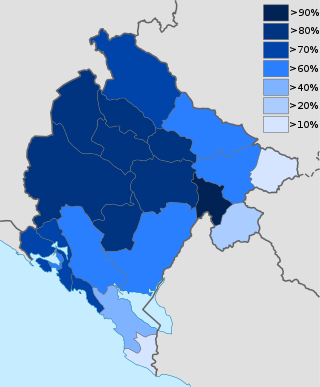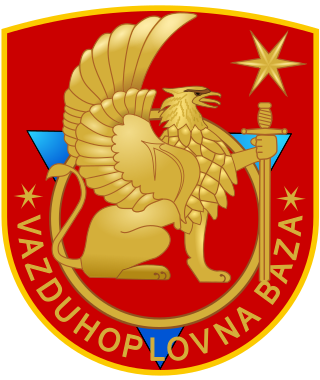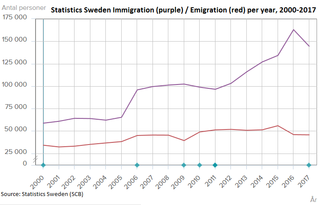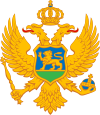
Montenegro is a country in Southeast Europe. It is bordered by Bosnia and Herzegovina to the north, Serbia to the northeast, Kosovo to the east, Albania to the southeast, and Croatia and the Adriatic Sea to the northwest with a coastline of 293.5 km. Podgorica is the country's capital and its largest city. It covers 10.4% of Montenegro's territory of 13,812 square kilometres (5,333 sq mi), and is home to roughly 31% of its total population of 621,000. Cetinje is the former royal capital and cultural centre of Montenegro and is the location of several national institutions, including the official residence of the President of Montenegro.

Podgorica is the capital and largest city of Montenegro. The city is just north of Lake Skadar and close to coastal destinations on the Adriatic Sea. Historically, it was Podgorica's position at the confluence of the Ribnica and Morača rivers and at the meeting-point of the fertile Zeta Plain and Bjelopavlići Valley that encouraged settlement. The surrounding landscape is predominantly mountainous terrain.

Nikšić, is the second largest city in Montenegro, with a total population of 56,970 located in the west of the country, in the centre of the spacious Nikšić field at the foot of Trebjesa Hill. It is the center of Nikšić Municipality with population of 72,443 according to 2011 census, which is the largest municipality by area and second most inhabited after Podgorica. It was also the largest municipality by area in the former Yugoslavia. It is an important industrial, cultural, and educational center.

Pljevlja is a town and the center of Pljevlja Municipality located in the northern part of Montenegro. The town lies at an altitude of 770 m (2,530 ft). In the Middle Ages, Pljevlja had been a crossroad of the important commercial roads and cultural streams, with important roads connecting the littoral with the Balkan interior. In 2011, the municipality of Pljevlja had a population of 30,786, while the city itself had a population of about 19,489 making it the fourth largest urban settlement in Montenegro. The municipality borders those of Žabljak, Bijelo Polje and Mojkovac in Montenegro, as well as Bosnia and Herzegovina to the west and Serbia to the northeast. With a total area of 1,346 km2 (520 sq mi), it is the third largest municipality in Montenegro.
The Democratic Party of Socialists of Montenegro is a social-democratic and populist political party in Montenegro. A former long-time ruling party sitting at the opposition for the first time as of 2020, it was formed on 22 June 1991 as the successor of the League of Communists of Montenegro, which had governed Montenegro within the Socialist Federal Republic of Yugoslavia since World War II, and has remained a major force in the country ever since. The party is a member of the Socialist International and the Progressive Alliance, and an associate of the Party of European Socialists. During the 1990s, DPS was the major centre-left, social-democratic party in favour of Serbian-Montenegrin unionism. However, since 1997, the party has embraced Montenegrin independence and has been improving ties with the West, slowly turning into a catch-all party embracing Atlanticism, Montenegrin nationalism, neoliberalism, and pro-Europeanism.

Milo Đukanović is a Montenegrin politician who served as the President of Montenegro from 2018 to 2023, previously serving in the role from 1998 to 2002. He also served as the Prime Minister of Montenegro and was the long-term president of the Democratic Party of Socialists of Montenegro, originally the Montenegrin branch of the League of Communists of Yugoslavia, which governed Montenegro alone or in a coalition from the introduction of multi-party politics in the early 1990s until its defeat in the 2020 parliamentary election. He is the longest-ruling contemporary politician in Europe, having held key positions in the country for over 33 years. However, he was defeated by the 36-year-old centrist former economy minister, Jakov Milatović, after the presidential run-off held on 2 April 2023.

Montenegrins are a South Slavic ethnic group that share a common ancestry, culture, history, and language, identified with the country of Montenegro.

Immigration to Germany, both in the country's modern borders and the many political entities that preceded it, has occurred throughout the country's history. Today, Germany is one of the most popular destinations for immigrants in the world, with well over 1 million people moving there each year since 2013. As of 2019, around 13.7 million people living in Germany, or about 17% of the population, are first-generation immigrants.

Krsto Popović was an officer of the Montenegrin Army who fought in the Balkan Wars and in the First World War.

The 1992 Montenegrin independence referendum was the first referendum regarding Montenegrin independence, held on 1 March 1992 in SR Montenegro, a constituent republic of the Socialist Federal Republic of Yugoslavia.
Montenegro was independent from the late middle ages until 1918, when it declared its union with Serbia and, subsequently, became part of various incarnations of Yugoslavia and the state union of Serbia and Montenegro. During this time, football in Montenegro was part of the wider Yugoslavian structures. As a result of the Montenegrin independence referendum held on May 21, 2006, Montenegro declared independence two weeks later, on June 3, and formed its own football association.

Amfilohije was a bishop of the Serbian Orthodox Church, theologian, university professor, author and translator. He was first the Bishop of Banat between 1985 and 1990, and then the Metropolitan Bishop of Montenegro and the Littoral from 1990, until his death. As the metropolitan bishop, he was the primate of the Serbian Orthodox Church in Montenegro. He was one of the most influential leaders of the Serbian Church, and was among the three candidates for the Serbian patriarchate both in 1990 and 2010.

The First League of Montenegro is the top professional football league in Montenegro. Founded in 2006, competition is headed by the Football Association of Montenegro. 10 teams participate in this league. The winner of the Montenegrin First League starts the qualifications for the UEFA Champions League from the second round. The second and third placed teams and Montenegrin Cup winner play in the qualifying rounds of the UEFA Conference League. The last placed team is directly relegated to the Montenegrin Second League, and the two next lowest ranked teams play in Montenegrin First League playoffs.

The Italian governorate of Montenegro existed from October 1941 to September 1943 as an occupied territory under military government of Fascist Italy during World War II. Although the Italians had intended to establish a quasi-independent Montenegrin kingdom, these plans were permanently shelved after a popular uprising in July 1941. Following the Italian surrender in September 1943, the territory of Montenegro was occupied by German forces which withdrew in December 1944.

Immigration to Finland is the process by which people migrate to Finland to reside in the country. Some, but not all, become Finnish citizens. Immigration has been a major source of population growth and cultural change throughout much of the history of Finland. The economic, social, and political aspects of immigration have caused controversy regarding ethnicity, economic benefits, jobs for non-immigrants, settlement patterns, impact on upward social mobility, crime, and voting behaviour.

The Montenegrin Air Force is the air arm of the Military of Montenegro. The aircraft marking of the Montenegrin Air Force consist of a red-on-gold roundel, currently being the sole air arm using the latter colour in its official insignia.

Immigration to Sweden is the process by which people migrate to Sweden to reside in the country. Many, but not all, become Swedish citizens. The economic, social, and political aspects of immigration have caused some controversy regarding ethnicity, economic benefits, jobs for non-immigrants, settlement patterns, impact on upward social mobility, violence, and voting behaviour.
A significant wave of immigration from the former Yugoslavia to Switzerland occurred during the 1990s and 2000s. While moderate numbers of Yugoslav citizens had residence in Switzerland during the 1980s, the bulk of immigration took place as a consequence of the Yugoslav Wars and by family reunion of those who had immigrated during this period.

The Montenegrin Derby is the main football match in Montenegro, between the teams from the two biggest Montenegrin cities. Rivals are FK Budućnost from Podgorica and FK Sutjeska from Nikšić, two most popular sports societies in Montenegro. The rivalry is present in football and basketball.
Two clubs played their derbies in Montenegrin Championship, First League of SFR Yugoslavia, FR Yugoslavia and Serbia and Montenegro, and today, four times on one season, in Montenegrin First League.

The Montenegrin diaspora consists of communities of ethnic Montenegrins and/or Montenegrin citizens living outside Montenegro. Estimates on its size are only approximate because of incomplete statistical records and naturalization, but (highest) estimates suggest that the Montenegrin diaspora may be as large as the nation's population of 620,000.


















